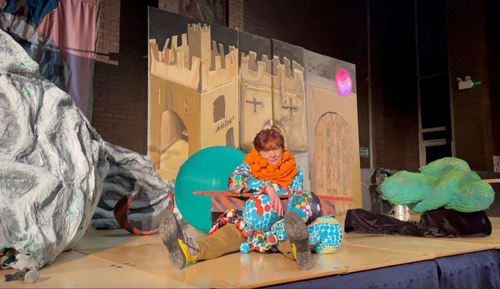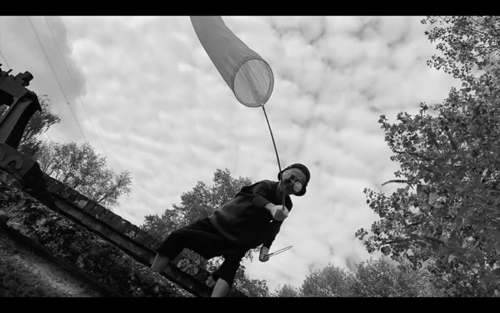|
Screening
Programme |
|
|
Booking is essential: please contact danielle@daniellearnaud.com Doors open at 6pm - the screenings will start promptly at 6.30pm
The event will screen artists videos where the role of music is central. The screenings will be the pretext for a mediated 30 minute discussion about how genres of music and moving image work in relation to experimental artistic video practices, offering a critical lens onto both the production and the reception of work. The event is also a strategy to extract artistic video practices from the white cube to develop curatorial contexts where audiences can engage with video work in new ways.
Mick Finch One Thing After Another 2024
The video is made from the image montage for a book entitled One
Thing After Another, published by Shibboleth, Milan. It was launched
at Printed Matter in NY and the video takes the paratactic sequence
of still images as the material for a montage using ‘Ken Burns’
editing methods. The video was used in a presentation about the book
and in a showreel in the fair. Mick Finch exhibits his work
regularly and internationally.
In 2011 he was an Abbey Fellow in Painting at the British
School in Rome and he is a Senior Scholar of the Terra Foundation in
Paris. He is a member
of the artistic committee of the Institut Français’ Fluxus Group.
He is also a member of the Faculty of Fine Art of the British
School at Rome. He has
written extensively about Aby Warburg and led an AHRC project
entitled A Vision for Europe (2019-20) that examined Warburg’s and
Fritz Saxl’s photographic practices.
At the University of the Arts, Central Saint Martins, London
he is Professor of Visual Art Practice. Since 2014 he has been
working on the Book of Knowledge project.
He has scanned some 3000 images from a set of 1950s
encyclopedias of the same name.
He has worked with this archive in terms of making digital
photo-collage and more recently as video montage.
He also makes the music for the videos, which plays an
intrinsic role in the work.
This is not a
memory project but a way of exploring a body of material that is
precisely inscribed, limited, locked in its time and its materiality
as printed matter and also
open to the present and the future. In April 2024 his artist
book, One Thing After Another, published by Shibboleth in Milan, was
launched at the Printed Matter art book fair in New York.
Book of Knowledge work has been shown at The Sid Motion
Gallery, The Terrace Gallery, The Post Room Gallery and the Art
Gazette Gallery.
Alex Schady These are not my dreams
2024
Part of an ongoing set of moving image works in which the relationship between an artist and their work is set to music and performed. These are not my dreams is made as a response to Songs for Dead Sculptures in which Schady sings to his sculptures. For this new work the sculptures are given voice and sing back to the artist asserting their own position. Schady worked with St Georges Panto group who perform the role of artworks within the piece. Alex Schady is an artist and
filmmaker with a broad interdisciplinary practice. His work uses
materials immediately to hand, incorporating modern-life ephemera
that is manipulated and re-interpreted across a variety of media.
Combining craft techniques and digital processes his most recent
work uses the language of science fiction to explore the psyche of
contemporary culture and the role of the artist within it. He is
co-founder of Five Years Gallery an artist-run space that
establishes a direct relationship between programming, curation and
practice.
Daria Blum Big Baby (I owe you nothing) 2021
'Freed a spider today.' Daria Blum (*1992 CH, based in London) multiplies herself across music, photography, text, video and live performance. Using theatrical devices and autofiction to mythologise her own history as an artist, she suggests how ‘breaking character’ can destabilise entrenched forms of engagement with the world. Blum completed a postgraduate degree from the RA Schools (2019-2023), having previously studied at Central Saint Martins (2014-2017). She has most recently exhibited and performed at Ilenia, London (2024); Roskilde Festival, Denmark (2023); V.O Curations, London (2022) and Piccadilly Lights, London (2022). She is currently artist in residence at CAPC Bordeaux as part of Fluxus Art Project’s Magnetic Residenc
Oona Grimes Etruscan moth 2020
Etruscan silk worm moth teasing and tempting a Buster Keatonesque
entomologist, choreographing an elusive expedition through the
undergrowth. Oona Grimes is a London-based artist, primarily a chaser of language through drawing, clay making and film. During Grimes' 2018 Bridget Riley Fellowship at the Brirtish School at Rome she segued from thieving Lorenzetti tartans and cartoon detail from Etruscan paintings, to the appropriation of neorealist films - mis-remembered, imitated and low tech re-enacted: a physical drawing of herself captured oni-phone.
Mario Rossi In Media Res 2022
In Medias Res is a collaborative work made with the Glasgow Improvisors Orchestra and was performed live at GioFest at CCA Glasgow in November 2022.The work animates an ongoing archive of cinematic related paintings with visual devices associated with both still and moving image. Mediation is at the core of the work; each sequence weaving image with sound and textural references, as quintessential forms dissolve ever more precipitously into a complete frictionless digital mediascape. Mario Rossi is a visual artist working across painting and film media. He has contributed to numerous exhibitions that explore the relationship between painting and cinema including: Sideshow Lethaby Gallery 2024, Wastemakers Winchester Gallery 2023, Go On Being So, Newlyn Art Gallery, 2020, As Seen on Screen : Walker Art Gallery, Liverpool 2019. Now, Today ,Tomorrow and Always 2017: Towner Art Gallery Eastbourne. UnSpooling: Artists and Cinema, 2012 Cornerhouse Manchester.
Paulette Phillips Marnie's Handbag 2008
Premiering at the Tate Modern on May 08, 2008, Marnie's Handbag was commissioned for London Fashion Week. The video uses appropriated clips from over 50 films that span Hollywood cinema from 1935 to 2007. The ‘behavioural paradox’ in Marnie's Handbag is centred on the signals and signs that are used in the language of film noir cinema. Here we are given a glimpse into the dress codes of the women driven to misbehave. Edited by Dennis Day this is a tour de force of female trouble. Paulette Phillips’ work deals with the relationship between viewer and subject, focusing on witnessing, looking and reflection. Consistent in her work is an interest in the way psychological content is embedded in the physical world. Over the past thirty years she has worked in visual art, film and theatre and for the past 15 years has primarily focused on sculpture and film installation showing her work primarily in the UK, France and Germany. Her work is in a number of public collections including the National Gallery Canada, Oakville Galleries, the Museum of Modern of Modern Art and Frac, Haute-Normandie and in corporate and private collections including Gluskin Sheff + Associates and BMO Bank of Montreal. Her work is represented by Danielle Arnaud Contemporary Art, London, and Diaz Contemporary, Toronto. Paulette teaches time-based and contemporary art practices at OCAD University.
Louisa Fairclough A Rose 2017
A Rose (2017) has two components in conversation with each other: a 16mm film and a vinyl dubplate recording, both made in a building on the site of a former psychiatric hospital, which is now entangled in vegetation and open to the elements. An upturned shelving unit – shown in the film – provided a platform onto which a lament was performed. Singer Samuel Middleton sang a cluster of words repeatedly that were recorded over-and-over on the same tape loop, creating a composite recording that captures the song resonating through the metal shelves along with the incidental sounds of the environment. This was then pressed onto vinyl dubplate, with the tempo of the song informing the pace of the film. The end words – erase, erase, erase – arise above the rest.
Louisa Fairclough’s work mainly takes the form of
film loops, choral performances, field recordings and drawings. She
is soon to start work on a second essay film exploring her lived
experience of psychosis.
Mark Dean The Way Of The Saints 2018-2023
The Way of the Saints combines footage from the introductory sequences of various episodes of the 1960’s TV series The Saint with a remix of samples from the 2000 single Black Coffee by All Saints. The technique of combining disparate material linked by a coincidence of names has been used by Dean since Goin’ Back (The Birds/The Byrds x 32 + 1), 1997, and relates to the ancient hermeneutic principle of gezerah shavah formulated by Rabbi Hillel the Elder (although this relationship may also be coincidental).
Mark Dean began looping appropriated film as an art
student in the late 1970’s, and in the 1980’s extended this
technique into music; these practices were eventually combined in
the methodology for which Dean became recognised as a video & sound
artist from the 1990’s onwards.
|
|
| >home | |




.jpg)


